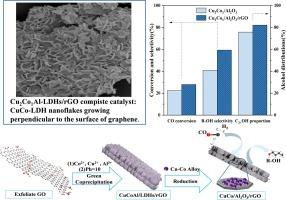原位生长在 rGO 上的 CuCoAl-LDHs 衍生的双金属 Cu-Co 催化剂,用于利用合成气合成酒精
IF 6.7
1区 工程技术
Q2 ENERGY & FUELS
引用次数: 0
摘要
利用柠檬酸盐辅助液相共沉淀方法,在 rGO 上成功原位合成了 CuCoAl-LDH 复合纳米材料,并首次将其应用于酒精合成。结构表征和形貌观察表明,该杂化材料由垂直排列、交叉且密集分布在 rGO 表面的六角形 LDH 纳米片组成。石墨烯支撑物极大地促进了 LDH 的分散,并防止了 LDH 晶体生长过程中强烈的层间堆叠。优化 Co/Cu 比例后,Cu2Co1/Al2O3/rGO 催化剂的总醇选择性达到 60%,其中 82% 为 C2+ 醇,反应 100 小时后未发现失活现象。石墨烯载体的加入大大减小了催化剂表面 Cu-Co 合金的粒径,颗粒高度分散在 Al2O3 基体和 rGO 表面。这种分散性促进了 Cu-Co 合金颗粒之间的强烈相互作用,而石墨烯的高导热性则有效抑制了热点的形成。此外,LDH 前驱体的有序三维纳米片结构提供了较大的比表面积和高度均匀分散的活性中心。这种结构不仅促进了具有高 CO 解离能力的桥式吸附位点的形成,平衡了多重键合和桥式 CO 吸附,还显著增加了 CO 插入的概率,从而提高了 HAS 的性能。本研究为制备 LDH/rGO 复合材料提供了一种有效的方法,展示了其广阔的潜在应用前景。本文章由计算机程序翻译,如有差异,请以英文原文为准。

Bimetallic Cu-Co catalyst derived from in-situ grown CuCoAl-LDHs on rGO for alcohols synthesis from syngas
Using a citrate-assisted liquid phase co-precipitation method, a CuCoAl-LDH composite nanomaterial was successfully synthesized in situ on rGO and applied to alcohol synthesis for the first time. Structural characterization and morphological observations indicate that the hybrid material consists of hexagonal LDH nanosheets that are vertically aligned, crossed and densely distributed on the rGO surface. The graphene support significantly promoted the dispersion of LDH and prevented strong interlayer stacking during LDH crystal growth. After optimization of the Co/Cu ratio, the Cu2Co1/Al2O3/rGO catalyst exhibited a total alcohol selectivity of 60 %, of which 82 % were C2+ alcohols, and no deactivation was observed after 100 h of reaction. The addition of the graphene support significantly reduced the particle size of the Cu-Co alloy on the catalyst surface, and the particles were highly dispersed on both the Al2O3 matrix and the rGO surface. This dispersion facilitated strong interactions between the Cu-Co alloy particles, while the high thermal conductivity of graphene effectively suppressed the formation of hotspots. In addition, the well-ordered three-dimensional nanosheet structure of the LDH precursor provides a large specific surface area and highly uniformly dispersed active centers. This structure not only promotes the formation of bridge adsorption sites with high CO dissociation ability, which balances multiple bonding and bridge CO adsorption, but also significantly increases the probability of CO insertion, thereby enhancing the performance of HAS. This study provides an effective method for the preparation of LDH/rGO composites, demonstrating their broad potential application prospects.
求助全文
通过发布文献求助,成功后即可免费获取论文全文。
去求助
来源期刊

Fuel
工程技术-工程:化工
CiteScore
12.80
自引率
20.30%
发文量
3506
审稿时长
64 days
期刊介绍:
The exploration of energy sources remains a critical matter of study. For the past nine decades, fuel has consistently held the forefront in primary research efforts within the field of energy science. This area of investigation encompasses a wide range of subjects, with a particular emphasis on emerging concerns like environmental factors and pollution.
 求助内容:
求助内容: 应助结果提醒方式:
应助结果提醒方式:


